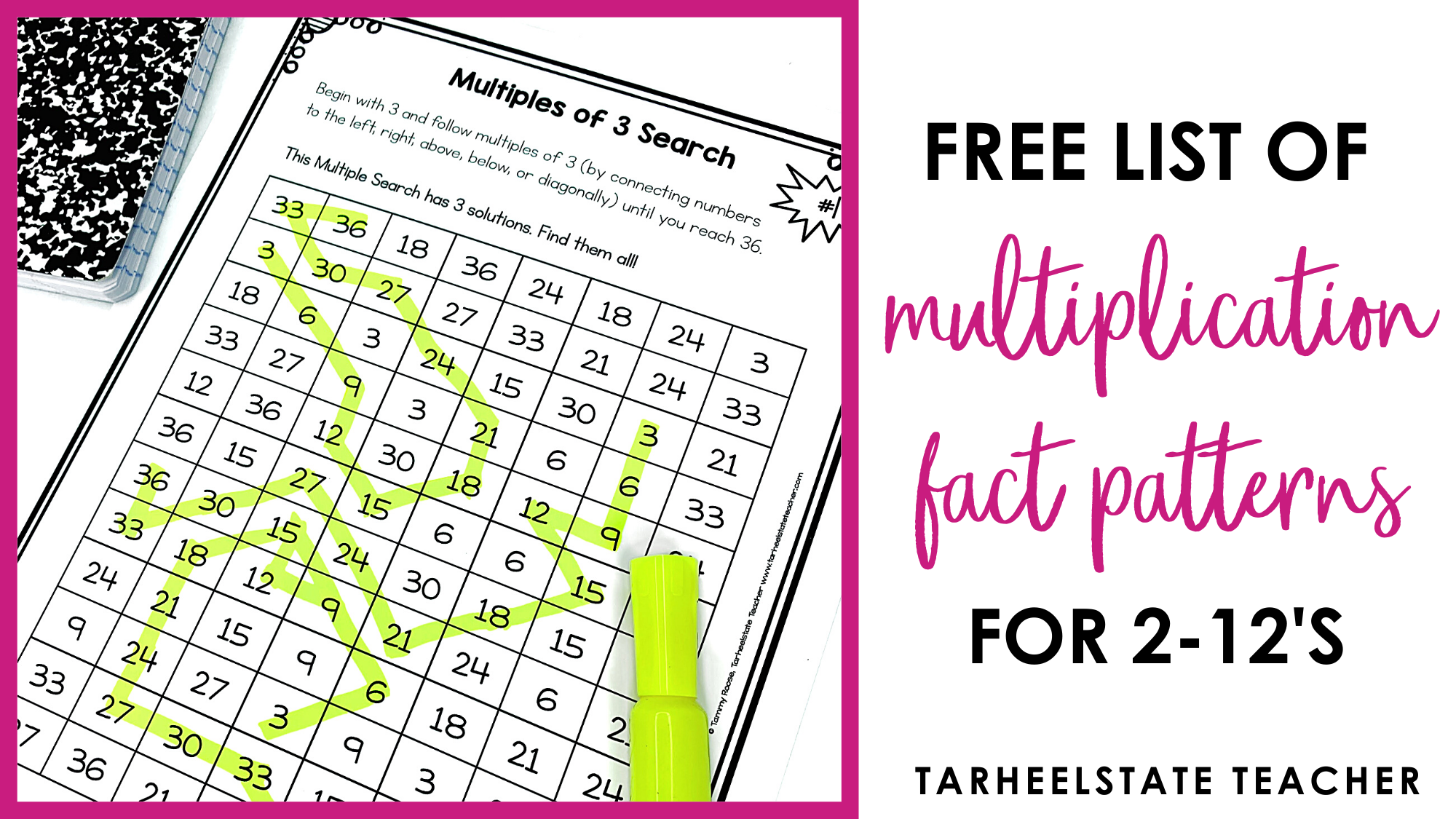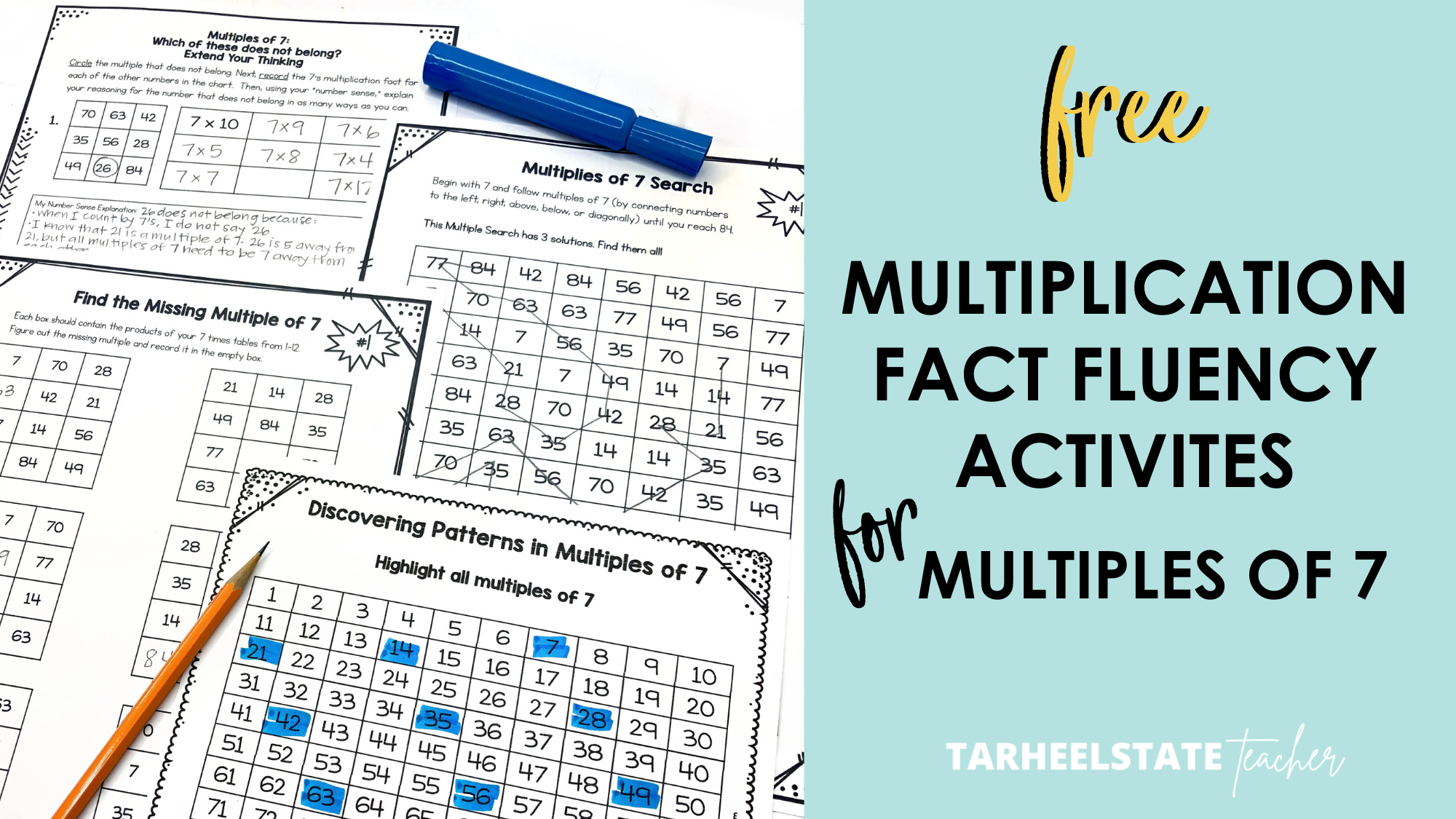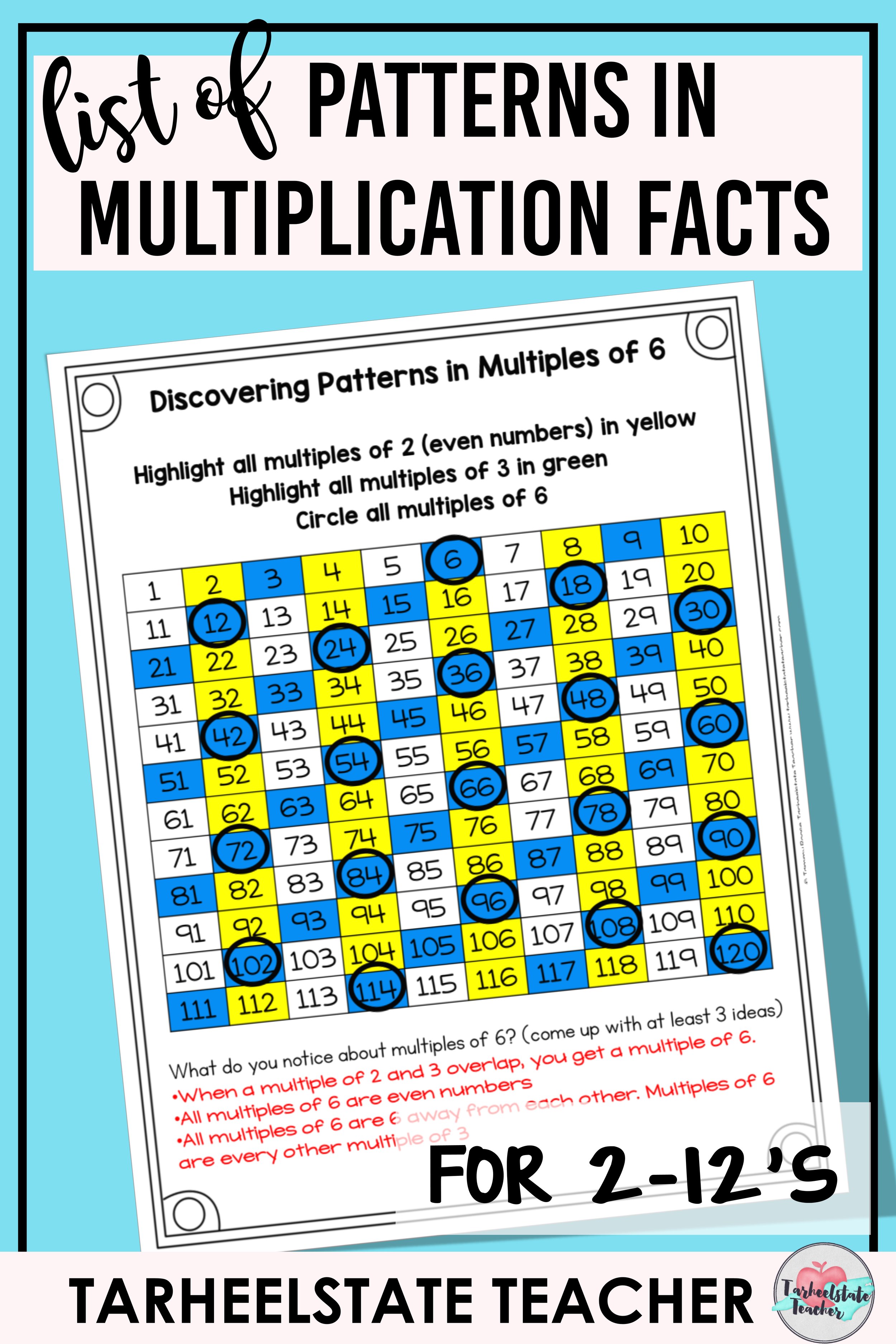Multiplication Patterns in Times Tables
What patterns exist in multiplication fact families? One of my favorite activities for helping students master multiplication facts is to use a 120’s chart to focus on building number sense and their understanding of patterns in the multiplication fact families. Today, I’m sharing the multiplication patterns I’m aware of (and hoping you will drop anything I’ve left out in the comments so we can all learn from each other!).
CAUTION: The patterns in multiplication facts and noticings that I am sharing ARE NOT MEANT TO BE TAUGHT TO STUDENTS. This is a list that can support you as you guide students to look for patterns in multiplication fact families. My goal is to provide you with a list of ideas that range from fairly obvious or basic to more sophisticated patterns that you can guide students to discover.
My real hope is that your students come up with ideas that I didn’t even think of, that you prompt students and their classmates to continue testing their theories beyond the 120 table and that you prove or disprove those ideas.
When prompting students to find and describe patterns in multiples using a 120’s table, two of my favorite prompts are:
“TELL ME ALL YOU CAN ABOUT (what patterns you see in multiples of 7)?…”
“WHAT DO YOU NOTICE ABOUT (patterns in multiples of 7)?…”
After a general prompting round, you can direct students to look at specific characteristics of the multiples. For example, “Tell me all you can about the ones place in multiples of 7.” and “What do you notice about the ones place in multiples of 7?”
LET’S GET TO THOSE PATTERNS IN THE 120’S CHART
Patterns in Multiplying by 2’s
All multiples of 2 have a pattern of 2, 4, 6, 8, or 0 in the ones place.
When multiplying ANY number by 2, the result is EVEN. When you multiply an odd number by 2, the “leftover” partner in each number will be able to partner up together. For example, the 7th piece in the number 7 can partner up with the 7th piece of the other 7 when 7 is doubled/multiplied by 2.
When looking at numbers 1-10, 11-20, 21-30, etc. even numbers/even columns alternate with odd numbers/odd columns.
There are 5 even numbers and 5 odd numbers in each range of 10 numbers (which is ½ or 50/50).
Even if the tens place or hundreds place is odd, a number can be even.
In an even number, everyone has a partner where as with an odd number, 1 number will not have a partner.
Patterns in Multiplying by 3’s
Multiples of 3 have a pattern of 3, 6, 9, 2, 5, 8, 1, 4, 7, 0 in the ones place.
Every other multiple of 3 is even.
The digits in multiples of 3 add up to a multiple of 3 (36 = 3 + 6, 111 = 1 + 1 + 1, etc.)
All EVEN multiples of 3 are also a multiple of 6 (the even multiples of 3 are the 6 “count by’s”).
Patterns in Multiplying by 4’s
Multiples of 4 have a pattern of 4, 8, 2, 6, 0 in the ones place.
Add 20 to any multiple of 4 and you have another multiple of 4 (follow the columns on a 120’s chart to see this in action!).
All multiples of 4 are 4 away from each other.
Each range of 10 alternates with 2 multiples of 4, 3 multiples of 4. (1-10 contains 2 multiples of 4; 11-20 contains 3 multiples of 4.)
Patterns in Multiplying by 5’s
Multiples of 5 have a pattern of 5, 0 in the ones place.
Every other multiple of 5 is even; every other multiple of 5 is odd.
Every range of 10 contains two multiples of 5.
Every other multiple of 5 is halfway between a 10.
Patterns in Multiplying by 6’s
Multiples of 6 have a pattern of 6, 2, 8, 4, 0 in the ones place.
When a multiple of 2 and 3 overlap, you get a multiple of 6.
All multiples of 6 are even numbers.
All multiples of 6 are 6 away from each other.
Multiples of 6 are every other multiple of 3.
Patterns in Multiplying by 7’s
Multiples of 7 have a pattern of 7, 4, 1, 8, 5, 2, 9, 6, 3, 0 in the ones place. Besides multiples of 9, 7’s have the greatest variety of numbers represented in the ones place—hitting every digit from 0 to 9 along the way! —> Have students continue the pattern beyond 119 to see how long it goes.
The ones place is 3 less with each increasing multiple (7, 4, 1 (or 11), 8, 5, 2 (or 12), 9, etc).
YOU CAN GET ALL OF THE NUMBER SENSE/MULTIPLICATION INTERVENTION ACTIVITIES FOR MULTIPLES OF 7 SENT STRAIGHT TO YOUR INBOX! Share your email below and join the rest of the Tarheelstate Teacher change-makers email community!
Patterns in Multiplying by 8’s
Multiples of 8 have a pattern of 8, 6, 4, 2, 0 in the ones place.
All multiples of 8 are even.
All multiples of 8 are multiples of 2 and 4.
To multiply a number by 8, you can double-double-double the number. (Example: 4 x 8 —> 4 doubled = 8, 8 doubled = 16, 16 doubled = 32. 4 x 8 = 32)
8’s only contain one multiple in each 10, except when the ones place is a zero like in 40 and 80. These tens have two multiples of 8.
Patterns in Multiplying by 9’s
Multiples of 9 have a pattern of 9, 8, 7, 6, 5, 4, 3, 2, 1, 0 in the ones place.
All multiples of 9 are one less than 10 away from each other. (So, we can add 10, subtract 1 to find the next multiple of 9.)
A multiple of 9 can be even or odd. 9 is odd, but the result of 9 x 2 (or 9 + 9) is even.
Multiples of 9 alternate—odd, even, odd, even, etc.
A multiple of 9 must also be a multiple of three because 9 is made up of 3 x 3.
The digits in a multiple of 9 add up to a multiple of 9 (9, 18, 27, etc) . The digits of every multiple of 9 up to 90 add up to 9.
As the tens digit increases by 1, the ones digit decreases by 1.
Patterns in Multiplying by 10’s
All multiples of 10 have a zero in the ones place
When multiplying by a 10, the other factor that was multiplied moves to the left one space (or one place value space to the left).
All multiples of 10 are also multiples of 2 and 5.
Multiples of 10 are always even because 10 is even (therefore, many groups of 10 will remain even.) This also means that multiples of 10 are divisible by 2.
All multiples of 10 are also divisible by 5.
Patterns in Multiplying by 11’s
The ones place and the tens place for all multiples of 11 under 100 are the same.
The ones place increases by 1 each time and then starts again after 0.
Each multiple is one less away from the next 10. 11 is 9 away from 20, 22 is 8 away from 30, 33 is 7 away from 40, and so on.
After 110, the next multiple is 121 and the pattern starts again.
Patterns in Multiplying by 12’s
All multiples of 12 are even
All multiples of 12 are multiples of 2, 3, 4, and 6
In the ones place, the pattern 2, 4, 6, 8, 0 repeats. This is because when you are adding 12, the tens increase each time, and the ones place counts by 2’s
When counting by 12’s, no multiples are in the 50’s or the 110’s.
MULTIPLICATION NUMBER SENSE ACTIVITIES
As math teachers (and perhaps parents reading this), we all want our students to have their multiplication facts ready to whip out in a snap! We know in our hearts that if multiplication facts are not on solid ground, most other concepts we’ll want to teach in 4th grade, 5th grade, and beyond will be more challenging to master.
Not to mention, the slow down in learning those other concepts when students don’t know and demonstrate confidence with their multiplication facts can actually create the belief that a student is “not good at math” when the truth is lack of multiplication fact fluency is holding them back.
If you know it’s time for a fresh approach to helping your students master their multiplication facts, Multiplication Facts Intervention Activities may be just what you are looking for!
With a focus on counting-by and patterns in multiplication facts, students complete a variety of activities to help them increase their number sense and master their multiplication (and as a by-product, their addition facts will be more solid!).
With activities like Find the Missing Multiple, Which Number Does Not Belong?, Multiples of x Searches (where students find a chain of multiples in a word search-like activity), and analyzing patterns in a 120's table, students practice their number sense and multiplication fact mastery in a variety of fun ways.
These activities go beyond memorization activities like multiplication fact flash cards and instead, offer students new and fresh ways to engage with their multiplication fact knowledge.
You can get an up-close look at the multiplication fact intervention activities by downloading the multiples of 2 and 7’s for free or grab the discounted bundle of 2’s - 12’s.
NEED DONE-FOR-YOU ACTIVITIES TO HELP STUDENTS MASTER MULTIPLICATION FACTS?
SHOP THE RESOURCES HERE:
MORE on Building “Number-Sense” through Count-By’s and Multiplication Fact Activities
You may be interested in checking out the first two posts in this multiplication facts mastery series:
⇒ Using Count-By Activities to Develop Number Sense for Improved Multiplication Fact Mastery: Read about the AH-ha moment I had with one of my students who was struggling to master her multiplication facts. This moment changed everything about how I approach multiplication fact mastery—and what I do when students are struggling to “memorize” their facts—SPOILER: memorizing facts is not my goal—but developing greater number sense for multiples and multiplication fact families in a way that impacts students’ mastery of multiplication facts is!
⇒ Routines for Developing Number Sense and Multiplication Fact Fluency:
Once you believe that count-by activities for number sense development is important for multiplication fact mastery, you’re ready to outline some routines to follow with students who need small-group interventions in order to improve their multiplication fact mastery!
Analyzing patterns in 120’s tables is one of the activities in my multiplication facts activities for number sense. You can get Multiples of 7 set sent to your inbox by sharing your info above or you can check out all of the Number Sense Intervention Tasks from 2’s -12’s. You can purchase each fact family set individually or grab the 2’s -12’s bundle for a huge savings. (The number sense bundle also includes 230 task cards activities (broken into fact family sets) using MULTIPLES ON A NUMBER LINE. Currently, these activities are exclusive to the bundle!) I have also recently added digital versions for those of you using Google Slides or Boom Cards.










